牛津小学英语总复习资料(上海版)
(完整版)上海牛津小学英语语法知识总结
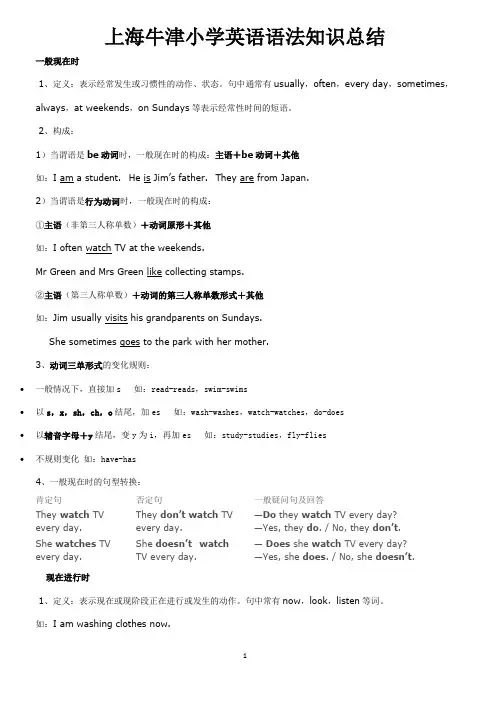
上海牛津小学英语语法知识总结一般现在时1、定义:表示经常发生或习惯性的动作、状态。
句中通常有usually,often,every day,sometimes,always,at weekends,on Sundays等表示经常性时间的短语。
2、构成:1)当谓语是be动词时,一般现在时的构成:主语+be动词+其他如:I am a student. He is Jim’s father.They are from Japan.2)当谓语是行为动词时,一般现在时的构成:①主语(非第三人称单数)+动词原形+其他如:I often watch TV at the weekends.Mr Green and Mrs Green like collecting stamps.②主语(第三人称单数)+动词的第三人称单数形式+其他如:Jim usually visits his grandparents on Sundays.She sometimes goes to the park with her mother.3、动词三单形式的变化规则:•一般情况下,直接加s 如:read-reads,swim-swims•以s,x,sh,ch,o结尾,加es 如:wash-washes,watch-watches,do-does•以辅音字母+y结尾,变y为i,再加es 如:study-studies,fly-flies•不规则变化如:have-has4、一般现在时的句型转换:肯定句否定句一般疑问句及回答They watch TV every day. They don’t watch TVevery day.—Do they watch TV every day?—Yes, they do. / No, they don’t.She watches TV every day. She doesn’t watchTV every day.—Does she watch TV every day?—Yes, she does. / No, she doesn’t.现在进行时1、定义:表示现在或现阶段正在进行或发生的动作。
上海版牛津英语六年级上、下全重点知识点复习整理
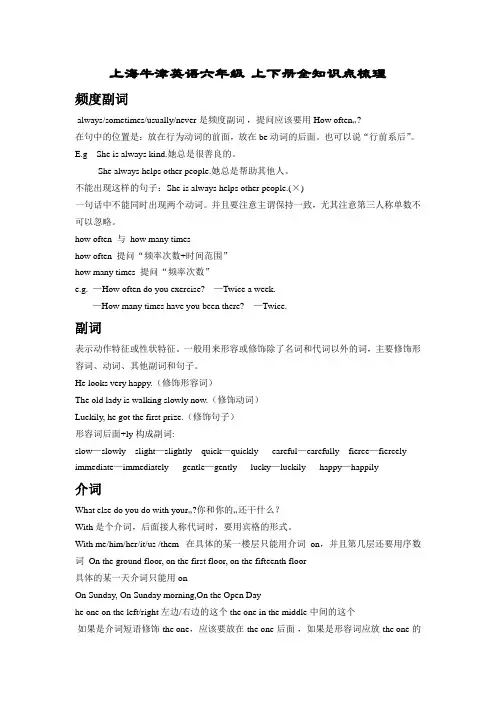
上海牛津英语六年级上下册全知识点梳理频度副词always/sometimes/usually/never 是频度副词,提问应该要用How often…?在句中的位置是:放在行为动词的前面,放在be动词的后面。
也可以说“行前系后”。
E.g She is always kind.她总是很善良的。
She always helps other people.她总是帮助其他人。
不能出现这样的句子:She is always helps other people.(×)一句话中不能同时出现两个动词。
并且要注意主谓保持一致,尤其注意第三人称单数不可以忽略。
how often 与how many timeshow often 提问“频率次数+时间范围”how many times 提问“频率次数”e.g. —How often do you exercise? —Twice a week.—How many times have you been there? —Twice.副词表示动作特征或性状特征。
一般用来形容或修饰除了名词和代词以外的词,主要修饰形容词、动词、其他副词和句子。
He looks very happy.(修饰形容词)The old lady is walking slowly now.(修饰动词)Luckily, he got the first prize.(修饰句子)形容词后面+ly构成副词:slow—slowly slight—slightly quick—quickly careful—carefully fierce—fiercely immediate—immediately gentle—gently lucky—luckily happy—happily介词What else do you do with your…?你和你的…还干什么?With是个介词,后面接人称代词时,要用宾格的形式。
牛津小学英语总复习资料(上海版)
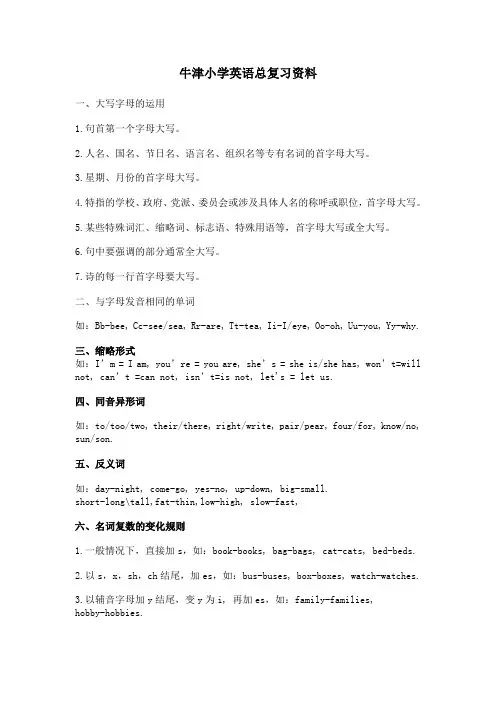
牛津小学英语总复习资料一、大写字母的运用1.句首第一个字母大写。
2.人名、国名、节日名、语言名、组织名等专有名词的首字母大写。
3.星期、月份的首字母大写。
4.特指的学校、政府、党派、委员会或涉及具体人名的称呼或职位,首字母大写。
5.某些特殊词汇、缩略词、标志语、特殊用语等,首字母大写或全大写。
6.句中要强调的部分通常全大写。
7.诗的每一行首字母要大写。
二、与字母发音相同的单词如:Bb-bee, Cc-see/sea, Rr-are, Tt-tea, Ii-I/eye, Oo-oh, Uu-you, Yy-why.三、缩略形式如:I’m = I am, you’re = you are, she’s = she is/she has, won’t=will not, can’t =can not, isn’t=is not, let's = let us.四、同音异形词如:to/too/two, their/there, right/write, pair/pear, four/for, know/no, sun/son.五、反义词如:day-night, come-go, yes-no, up-down, big-small.short-long\tall,fat-thin,low-high, slow-fast,六、名词复数的变化规则1.一般情况下,直接加s,如:book-books, bag-bags, cat-cats, bed-beds.2.以s,x,sh,ch结尾,加es,如:bus-buses, box-boxes, watch-watches.3.以辅音字母加y结尾,变y为i, 再加es,如:family-families,hobby-hobbies.4.以f或fe结尾,变f或fe为v, 再加es,如:thief-thieves, knife-knives.5.以o结尾,加es,如:mango-mangoes.加s,如:radio-radios,photo-photos.6.不规则变化,如:man-men, woman-women, child-children, foot-feet, tooth-teeth.7.不可数名词有:bread, juice, tea, coffee, water, rice等。
最新牛津上海版英语六年级下册全册复习资料
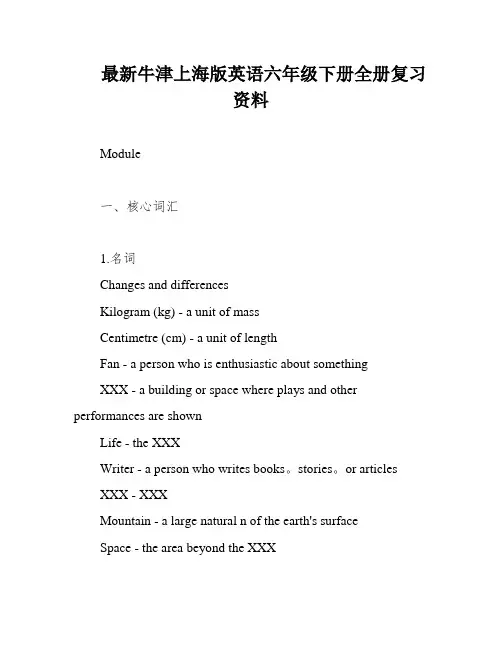
最新牛津上海版英语六年级下册全册复习资料Module一、核心词汇1.名词Changes and differencesKilogram (kg) - a unit of massCentimetre (cm) - a unit of lengthFan - a person who is enthusiastic about somethingXXX - a building or space where plays and other performances are shownLife - the XXXWriter - a person who writes books。
stories。
or articlesXXX - XXXMountain - a large natural n of the earth's surfaceSpace - the area beyond the XXX2.动词Weigh - to determine the weight of somethingDrive - to operate a XXXCarry - to hold or support something while moving3.其他Poor - XXXEven - used to XXX4.短语Street cleaner - a person who cleans the streets二、拓展词汇1.名词Photographer - a person who takes photographsFilm - a XXX flexible strip coated with light-sensitive XXX Broom - a long-XXX sweepingWife - a married womanFairy - XXXPS - postscript。
a note added to the end of a letter after the signatureDinosaur - XXX years ago2.动词Sweep - to clean a surface using a broom3.形容词- extremely goodDigital - XXX4.副词Online - connected to the。
小学英语知识点汇总(沪教牛津版)
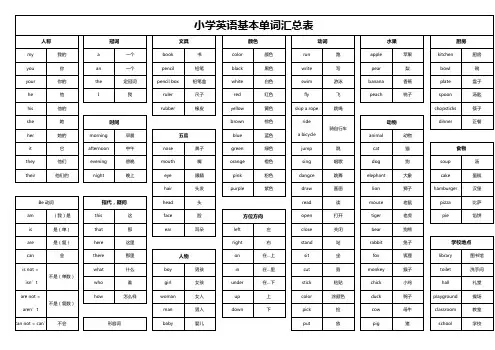
基本句型Goodbye 再见Good morning 早上好Good afternoon 下午好I’m…我是…Nice to see you 很高兴看到你Give me …, please 请给我…Here you are 给你This is my…这是我的…What can you do? 你会什么?I can …我会…Can you …? 你会…? Yes, I can. / No, I can’t 是的,我会Who is she/he? 她/他是谁?She’s/He’s …她/他是…May I have a/an …please? 我要…Thank you 谢谢你Can I help you? 我能帮你吗?How many …? 有多少…? There is/are …那儿有…What’s this/that? 这/那是什么?It’s a …它是…Is this/that …? 这是/那是…Yes/No 是的/不是There is a/an …那儿有一个…What color is it? 它是什么颜色?It’s…它是…How are you? 你好吗?I’m fine. Thank you./I’m fine too. 我很好,谢谢!I’m very well. Thank you 我很好,谢谢!I hope that you are too. 我希望你也是what can you see? 你能看到什么I can see …我能看到…Put …in/on …把…放…里/上What’s your name? 你叫什么名字?My name’s …我的名字是…How old are you? 你几岁了?I’m …我…岁Who’s your friend? 谁是你的朋友?Can I help you? 我能帮你吗?How much? 多少钱?什么价格?。
复习资料(知识清单)牛津上海版(三起)英语四年级下册
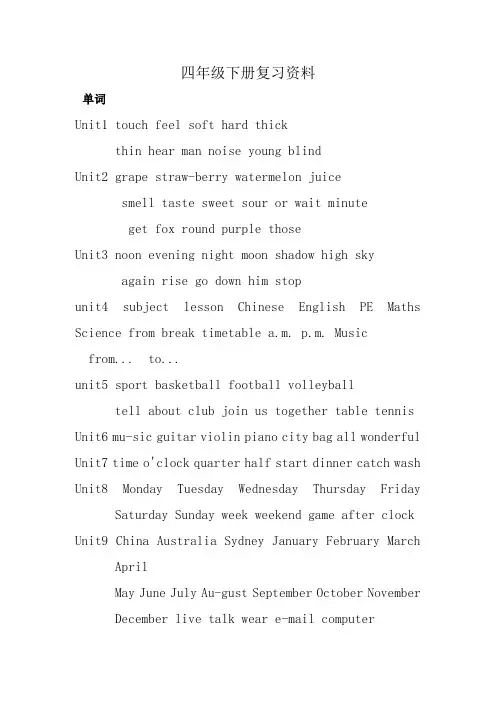
四年级下册复习资料单词Unit1 touch feel soft hard thickthin hear man noise young blindUnit2 grape straw-berry watermelon juicesmell taste sweet sour or wait minuteget fox round purple thoseUnit3 noon evening night moon shadow high skyagain rise go down him stopunit4 subject lesson Chinese English PE Maths Science from break timetable a.m. p.m. Musicfrom... to...unit5 sport basketball football volleyballtell about club join us together table tennisUnit6 mu-sic guitar violin piano city bag all wonderfulUnit7 time o'clock quarter half start dinner catch washUnit8 Monday Tuesday Wednesday Thursday FridaySaturday Sunday week weekend game after clockUnit9 China Australia Sydney January February MarchAprilMay June July Au-gust September October NovemberDecember live talk wear e-mail computerUnit10 gar-den plant leaf water grow all Seed them Unit11 cinema museum zoo Canada India Thailandsong alsoUnit12 duckling swan duck river ugly baby later back behind away quack into短语at noon/ night go down take a walk from...to... play football/basketball/volleyball play the violin/guitar/pianowash...face brush...teeth get up half past...go to school/bed have breakfast/lunch/dinner play chessat the weekend (be) late for have a party look into swim away well done wait a minute look at句型结构1.对某物进行确认:Is it a/an+可数名词单数?-- Yes, it is. / No, it isn't. Are they/these/those+可数名词复数?---Yes, they are./ No, they aren't.2.选择疑问句:Is it+选项A+or+选项B?---It is s+选项A/选项BAre they+ 选项A+ or+ 选项B ? .-They are+ 选项A/选项B (选项如是名复名词要用复数形式。
2019-2020学年牛津上海版英语(三起)三年级下册全册复习资料
Module Usingmyfivesenses一、核心词汇1.颜色词black黑色的blue蓝色的green绿色的red红色的white白色的yellow黄色的orange橙色的2.食物词candy糖果lemon柠檬icecream冰淇淋3.味觉形容词sour酸的sweet甜的4.交通工具名词bike自行车bus公共汽车plane飞机ship船car小汽车train火车5.动词hear听见listen听6.玩具名词ball球7.疑问词how怎么,怎样8.情态动词can能9.连词and和;同10.其他colour颜色taste味道;尝二、拓展词汇1.颜色词pink粉色的purple紫色的grey灰色的golden金黄色的violet紫罗兰色的2.食物词chocolate巧克力donut甜甜圈mango芒果cherry樱桃pineapple菠萝3.味觉形容词bitter苦的hot辣的salty咸的4.交通工具名词subway地铁taxi出租车raft木筏boat小船jeep吉普truck卡车5.疑问词what什么where哪里who谁whose谁的which哪一个when什么时候why为什么6.情态动词may可能must必须will将要could能够should应该would将要7.连词but但是or或者三、核心句型1.—Whatcolourisyourball?你的球是什么颜色的?—It’sredandwhite.它是红白相间的。
详解:“whatcolour”的意思是“什么颜色”,用来对物品的颜色进行提问。
当主语是单数形式时,be动词用is,答语用“It’s+颜色.”;当主语是复数形式时,be动词用are,答句用“They’re+颜色.”。
举一反三:—Whatcolourisyourpen?你的钢笔是什么颜色的?—It’sblue.它是蓝色的。
—Whatcolouristhepanda?熊猫是什么颜色的?—It’sblackandwhite.它是黑白相间的。
上海版牛津英语重点知识整(横版)精编资料
上海版牛津英语重点知识整(横版)上海版牛津英语重点知识整理(1A)仅供学习与交流,如有侵权请联系网站删除谢谢2仅供学习与交流,如有侵权请联系网站删除谢谢3 上海版牛津英语重点知识整理(1B)上海版牛津英语重点知识整理(2A)仅供学习与交流,如有侵权请联系网站删除谢谢4上海版牛津英语重点知识整理(2B)仅供学习与交流,如有侵权请联系网站删除谢谢5仅供学习与交流,如有侵权请联系网站删除谢谢6仅供学习与交流,如有侵权请联系网站删除谢谢7 上海版牛津英语重点知识整理(3A)上海版牛津英语重点知识整理(3B)一仅供学习与交流,如有侵权请联系网站删除谢谢8仅供学习与交流,如有侵权请联系网站删除谢谢9上海版牛津英语重点知识整理(3B)二仅供学习与交流,如有侵权请联系网站删除谢谢10仅供学习与交流,如有侵权请联系网站删除谢谢11 补充知识整理2A sweep ferry belt2B skip umbrella tap towel soap toothpaste spoon thirsty shells3A clap wave bow zebea biscuit shape triange dish ladybird insect root camera3B toothpick spin spinner mirror dill jam joun rough smooth sour peh lizards rainbow violet lorry raindrops pitter patter gloves photograph4A dive engine ambulance below string tape toilet4AM1u1This is my sister.Her name’s Wendy.Good bye!See you.She can run.She can’t cook.仅供学习与交流,如有侵权请联系网站删除谢谢12Can you swim?Yes, I can. /No, I can’t.butM1U2How old are you, Alice?I’m nine.How old is Alice?She’s nine.Happly birthday to you.What’s your name?I’m Ben.Is this your pencil. Kitty.Yes, it’s my pencil.No, it isn’t my pencil.M1U3What are you?What is he/she?What am I?What does your mother do?She’s a dentist.What does your father do?He’s a doctor.Are you a fireman?仅供学习与交流,如有侵权请联系网站删除谢谢13Yes, I’m a fireman.No, I’m not a fireman.M2U1I’m Alice Wang.I’m nine years old.You can call me Alice.Hello, My name is …My hair is short and black.My eyes are long.My nose is big.My mouth is small.My face is round.’s and thatM2U2I have a new skateboard.A ladybird is in the toilet.He is on Ben’s bed.Sam likes your chair.Sam doesn’t like cats.M2U3She has short hair.仅供学习与交流,如有侵权请联系网站删除谢谢14I have a friend.His name’s Mark.We have two friends.The have a cat.Nice to meet you.Whose dog is that?5AM3U1There are two floors.There are forty desks and forty chairs in my classroom. How many girls are there in your class?What time do you go home?I go to school by bus.Peter goes to school by car.M3U2Excuse me.I want a new umbrella.This one’s nice.It’s too small.仅供学习与交流,如有侵权请联系网站删除谢谢15How much money have you got?I’ve got eighty yuan.M3U3Which one means ……Don’t run! It’s dangerous.Which one means ‘Don’t eat’?You can’t play football here.Why not?Look at the sign!M4U1Does it like fruit?Yes, it likes fruit.What colour is the monkey?It is brown.Does it eat sweets?No, it doesn’t eat sweets.Where do monkeys live?It lives in a zoo.Can a monkey swim?Yes, it can.M4U2I don’t know, Kitty.Let’s look at this book.How do you spell that in English?M4U3仅供学习与交流,如有侵权请联系网站删除谢谢16I don’t know this place.Let’s go to the restaurant.三年级起点 3AM1 Getting to know you.Hello, I’m Peter.Good morning, Mr Rabbit.Good morning, Miss Cat.How are you?I’m fine. Thank you.Are you Kitty?Yes, I am.Are you a girl?No, I’m not.M2 My family, my friends and me. This is Kitty.仅供学习与交流,如有侵权请联系网站删除谢谢17She’s thin.Is he Joe?Yes, he is.Is she Mary?No, she isn’t.Who is he?He’s my father.My hair is long.My ears are small.M3 Places and activities.Good afternoon.Close the door, please.How much is it?How much are they?Five yuan.Here you are.This is my bed.These are my books.Is this your pen, Dad?Yes, it is. Thank you, Alice.No, it isn’t.Are these your rulers, Alice?Yes, they are. Thank you, Mum. No, they aren’t.仅供学习与交流,如有侵权请联系网站删除谢谢18M4 The world around us.How many boys?Three boys.What is it?It is a rabbit.In spring, it is warm.仅供学习与交流,如有侵权请联系网站删除谢谢19。
2019-2020学年牛津上海版英语(三起)三年级下册全册复习资料
Module Usingmyfivesenses一、核心词汇1.颜色词black黑色的blue蓝色的green绿色的red红色的white白色的yellow黄色的orange橙色的2.食物词candy糖果lemon柠檬icecream冰淇淋3.味觉形容词sour酸的sweet甜的4.交通工具名词bike自行车bus公共汽车plane飞机ship船car小汽车train火车5.动词hear听见listen听6.玩具名词ball球7.疑问词how怎么,怎样8.情态动词can能9.连词and和;同10.其他colour颜色taste味道;尝二、拓展词汇1.颜色词pink粉色的purple紫色的grey灰色的golden金黄色的violet紫罗兰色的2.食物词chocolate巧克力donut甜甜圈mango芒果cherry樱桃pineapple菠萝3.味觉形容词bitter苦的hot辣的salty咸的4.交通工具名词subway地铁taxi出租车raft木筏boat小船jeep吉普truck卡车5.疑问词what什么where哪里who谁whose谁的which哪一个when什么时候why为什么6.情态动词may可能must必须will将要could能够should应该would将要7.连词but但是or或者三、核心句型1.—Whatcolourisyourball?你的球是什么颜色的?—It’sredandwhite.它是红白相间的。
详解:“whatcolour”的意思是“什么颜色”,用来对物品的颜色进行提问。
当主语是单数形式时,be动词用is,答语用“It’s+颜色.”;当主语是复数形式时,be动词用are,答句用“They’re+颜色.”。
举一反三:—Whatcolourisyourpen?你的钢笔是什么颜色的?—It’sblue.它是蓝色的。
—Whatcolouristhepanda?熊猫是什么颜色的?—It’sblackandwhite.它是黑白相间的。
上海版牛津英语六年级(上下)全重点知识点复习整理
上海版牛津英语六年级(上下)全重点知识点复习整理上海版牛津英语六年级(上、下)全重点知识点复习整理上海牛津英语六年级上下册全知识点梳理频度副词always/sometimes/usually/never是频度副词,提问应该要用howoften??在句中的边线就是:放到犯罪行为动词的前面,放到be动词的后面。
也可以说道“行前系后”。
e.gsheisalwayskind.她总是很正直的。
shealwayshelpsotherpeople.她总是帮助其他人。
不能出现这样的句子:sheisalwayshelpsotherpeople.(×)一句话中无法同时发生两个动词。
并且必须特别注意主谓保持一致,尤其特别注意第三人称单数不可以忽略。
howoften与howmanytimeshowoften回答“频率次数+时间范围”howmanytimes回答“频率次数”e.g.―howoftendoyouexercise?―twiceaweek.―howmanytimeshaveyoubeenthere?―twice.副词则表示动作特征或性状特征。
通常用以形容或润色除了名词和代词以外的词,主要润色形容词、动词、其他副词和句子。
helooksveryhappy.(润色形容词)theoldladyiswalkingslowlynow.(修饰动词)luckily,hegotthefirstprize.(修饰句子)形容词后面+ly构成副词:slow―slowlyslight―slightlyquick―quicklycareful―carefullyfierce―fiercelyim mediate―immediatelygentle―gentlylucky―luckilyhappy―happily介词whatelsedoyoudowithyour??你和你的?还干什么?with就是个介词,后面直奔人称代词时,必须用宾格的形式。
- 1、下载文档前请自行甄别文档内容的完整性,平台不提供额外的编辑、内容补充、找答案等附加服务。
- 2、"仅部分预览"的文档,不可在线预览部分如存在完整性等问题,可反馈申请退款(可完整预览的文档不适用该条件!)。
- 3、如文档侵犯您的权益,请联系客服反馈,我们会尽快为您处理(人工客服工作时间:9:00-18:30)。
牛津小学英语总复习资料一、大写字母的运用1.句首第一个字母大写。
2.人名、国名、节日名、语言名、组织名等专有名词的首字母大写。
3.星期、月份的首字母大写。
4.特指的学校、政府、党派、委员会或涉及具体人名的称呼或职位,首字母大写。
5.某些特殊词汇、缩略词、标志语、特殊用语等,首字母大写或全大写。
6.句中要强调的部分通常全大写。
7.诗的每一行首字母要大写。
二、与字母发音相同的单词如:Bb-bee, Cc-see/sea, Rr-are, Tt-tea, Ii-I/eye, Oo-oh, Uu-you, Yy-why.三、缩略形式如:I’m = I am, you’re = you are, she’s = she is/she has, won’t=will not, can’t =can not, isn’t=is not, let's = let us.四、同音异形词如:to/too/two, their/there, right/write, pair/pear, four/for, know/no, sun/son.五、反义词如:day-night, come-go, yes-no, up-down, big-small.short-long\tall,fat-thin,low-high, slow-fast,六、名词复数的变化规则1.一般情况下,直接加s,如:book-books, bag-bags, cat-cats, bed-beds.2.以s,x,sh,ch结尾,加es,如:bus-buses, box-boxes, watch-watches.3.以辅音字母加y结尾,变y为i, 再加es,如:family-families,hobby-hobbies.4.以f或fe结尾,变f或fe为v, 再加es,如:thief-thieves, knife-knives.5.以o结尾,加es,如:mango-mangoes.加s,如:radio-radios,photo-photos.6.不规则变化,如:man-men, woman-women, child-children, foot-feet, tooth-teeth.7.不可数名词有:bread, juice, tea, coffee, water, rice等。
(不可数名词相对应的be动词是is/was)七、名词所有格表示人或物品所属关系时,就需要使用名词所有格。
名词所有格的构成有以下规则:1.一般情况下,在名词的末尾加’s构成。
如:Tom’s book2.以“-s”结尾的复数名词的所有格,只在其末尾加’。
如:our teachers’ books3.表示几个人共同拥有的东西时,只在最后一个名字上加所有格。
如:Su Hai and Su Yang’s bedroom八、a, an和the的用法1.单词或字母的第一个读音是辅音读音:a book, a peac h, a “U”.单词或字母的第一个读音是元音读音:an egg, an hour, an “F”.2.the要注意的:球类前面不加the,乐器前面要加the,序数词前面要加the。
九、人称代词和物主代词人称代词:1.人称代词分为第一、第二、第三人称,且有单复数之分。
2.人称代词的主格在句中做主语,一般用在动词前(疑问句除外)。
3.人称代词的宾格在句中做宾语,多用于动词、介词后。
4.人称代词能代替表示人称的名词。
物主代词:1.表示所有关系的代词叫做物主代词。
2.物主代词分为形容词性物主代词和名词性物主代词。
物主代词也有人称和数的变化。
3.形容词性物主代词起形容词的作用,后面一定要跟名词,表示该名词所代表的事物是属于谁的。
4.名词性物主代词=形容词性物主代词+名词。
如:This is my bag.= This is mine. 熟记人称代词和物主代词的绕口令:我是" I " ,你是“you","he, she, it" 他,她,它"我的“my”,你的"your",他的"his", 她的"her"十、形容词、副词的比较级1.形容词的比较级:用于两者的比较。
(1)基本句式的构成:A(主格)+ be + 形容词的比较级 + than + B(宾格).(2)表示一样的情况时用原级,结构是:as + 原级 + as2.副词的比较级:(1)基本句式的构成:A(主格)+ 动词 + 副词的比较级 + than + B(宾格).(2)表示一样的情况时用原级,结构是:as + 原级 + as3.形容词、副词比较级的变化规则:(1)单音节词末尾加er;(2)单音节词如果以字母e 结尾,加r;(3)重读闭音节词如果末尾只有一个辅音字母,须双写这个字母,再加er;(4)以辅音字母加y结尾,变y为i,再加er;(5)双音节和多音节词的比较级在原级前加more;(6)不规则变化, 如:well-better, much/many-more。
十一、基数词和序数词1.one--first, two--second, three--third, five--fifth, nine--ninth,twelve--twelfth, twenty-twentieth, forty-one--forty-first.序数词前一定要加the。
2.基数词变成序数词的方法:(1)直接在基数词词尾加上th,如:seventh第七,tenth 第十,thirteenth 第十三;(2)以y结尾的基数词,变y为ie,再加上th,如:twentieth 第二十。
(3)不规则变化,如:first 第一, second 第二, third 第三,fifth 第五,eighth 第八,ninth 第九,twelfth 第十二。
(4)基数词“几十几”变为序数词时,表示“几十”的基数词不变,只把表示“几”的基数词变成序数词,如twenty-first 第二十一。
3.序数词的缩略形式是由阿拉伯数字和序数词的最后两个字母构成的,如:1st, 2nd, 3rd, 4th。
十二、be动词(am, is, are)1.口诀:我用am, 你用are, is用在他她它,复数全用are。
2.否定形式:am not(没有缩写形式), is not=isn’t, are not=aren’t。
3.过去式:am/is(was), are(were)。
十三、情态动词(can,must,could,would,may,shall,should)1.情态动词后面用动词原形。
2.其否定形式是在情态动词的后面加not。
十四、助动词(do, does, did)1.do, does用于一般现在时,does用于第三人称单数,其余一律用do。
2.did用于一般过去时。
3.它们的否定形式为:do not=d on’t, does not=doesn’t. did not=didn’t.十五、介词in的用法:1.用在某范围或某空间内,如:in the desk2.在一段时间内,如:in the morning3.以,用……方式,如:in Englishin和on的区别:树上长出来的用on,不是树上长出来的则用in。
in, on, at的区别:in, on, at都可以用来放在时间前面,但是in后面一般是morning,afternoon,evening,月份、年份、季节或者指某一段时间内;on用在具体某一天,如:on Sunday morning;at一般用在某个假期期间(不是指具体的某一天),它还可以用在具体的时间,如:at Spring Festival, at five o’clock.小学英语教材中出现的介词有:in, on, from, of, by, about, for, under, behind, after, before, with, near, off, at, to, around, nearby等。
十六、特殊疑问词十七、there be结构与have, has的区别there be结构:1.there be结构表示“某地存在着什么事物或人”。
在一般现在时中,there be结构应该用there is 或there are 表示;在一般过去时中,there be结构则应该用there was或there were表示。
2.主语是不可数名词或单数可数名词时用is(was),是复数时用are(were)。
3.there be结构遵循就近原则。
4.在陈述句中为了强调地点,可将介词短语提到句首。
5.否定句:在be动词后面加not,如果句中有some,要变成any。
6.一般疑问句:把be动词提到句首,首字母大写,句尾改成问号。
7.What is + 地点介词短语?(无论主语是单数还是复数都用is)there be结构与have, has的区别:there be 表示某地存在着什么事物或人;have(has) 表示某物或人拥有某物。
十八、现在进行时1.现在进行时表示现在正在进行或发生的动作。
常与now连用,当句首有look, listen时,也用现在进行时。
2.现在进行时肯定句的基本结构为:主语+ be动词+动词的现在分词(doing,即动词的ing形式)(1)其中be动词随着主语的变化而变化,be动词包括am, is, are。
(2)动词现在分词的变化规则:A 一般情况下,直接在动词后加ing,如:cook-cooking.B 以不发音的e结尾的动词,去掉e后加ing,如:make-making, dance-dancing.C 以重读闭音节结尾的动词,双写末尾字母后加ing, 如:run-running,swim-swimming.D 以ie结尾的动词,变ie为y,再加ing, 如:lie-lying, die-dying.3.现在进行时的否定句:在be动词后面加not。
4.现在进行时的一般疑问句:把be动词提到句首,首字母大写,句尾改成问号。
十九、一般现在时1.一般现在时表示一般情况下经常发生的动作或存在的状态。
常与 usually, sometimes, often, always等词连用。
2.一般现在时的谓语动词为be动词时,be的变化遵循“我用am, 你用are, is 用在他她它,复数全用are”的规律。
3.一般现在时的谓语动词为其它动词时,当主语为第三人称单数时,动词要用第三人称单数形式。
如:Mary likes Chinese.玛丽喜欢汉语。
4.动词第三人称单数的变化规则:(1)一般的动词,直接在词尾加s,如:cook-cooks, like-likes.(2)以s,x,sh,ch,o等结尾的动词,加es,如:wash-washes, watch-watches, go-goes, do-does.(3)以辅音字母加y结尾的动词,变y为i, 再加es,如:study-studies.(4)不规则变化,如:have-has.5.一般现在时的变化:(1)be动词的变化。
